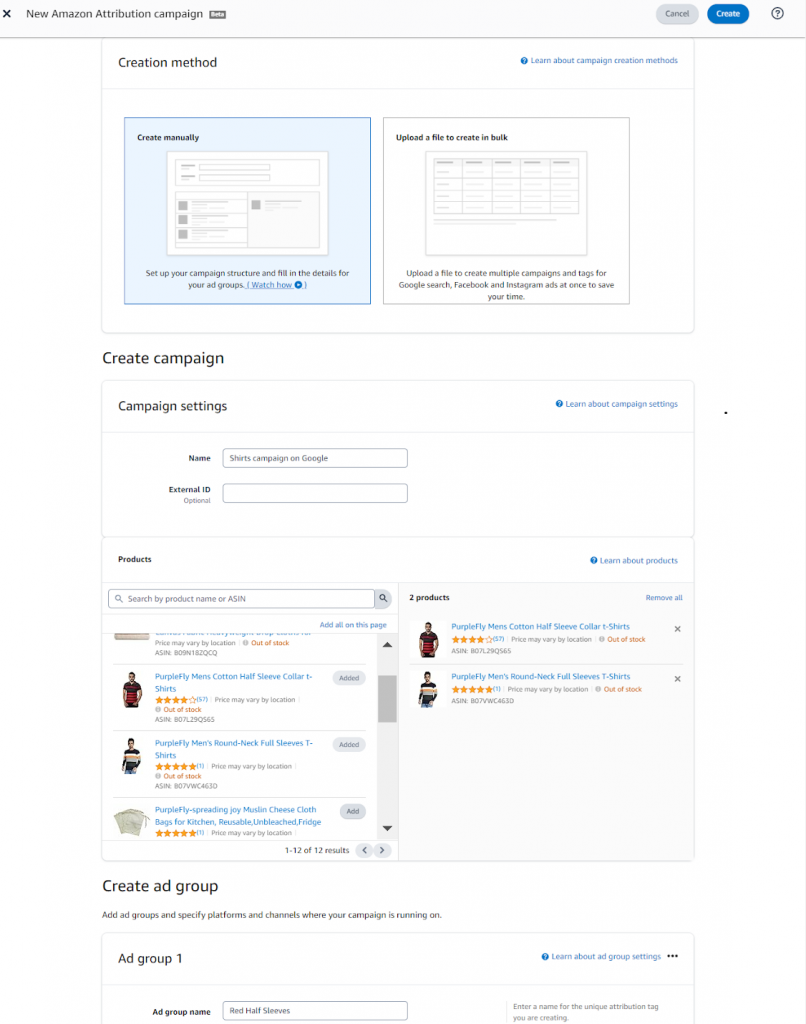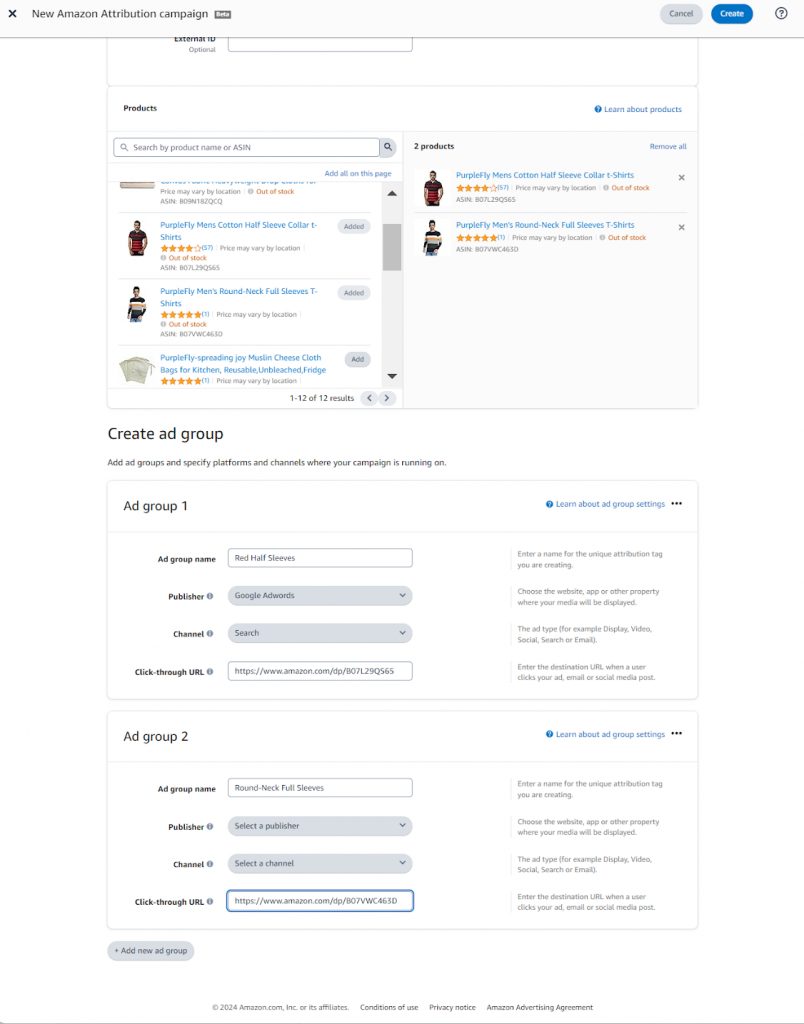In paid search advertising, the ability to measure the effectiveness of your campaigns is paramount. If you’re an Amazon seller using Google Ads to promote your products or store on Amazon, you’re likely no stranger to the challenge of tracking the performance of Google Ads and understanding its impact on your Amazon sales. Thankfully, there’s a game-changing solution at your fingertips – Amazon Attribution.
In this comprehensive guide, we’ll look into how Amazon Attribution can help measure the success of your Google Ads campaigns on Amazon. We’ll explore the two ways to enable Attribution, i.e, doing it all manually and utilizing Amazon Ads APIs. These methods cater to different needs and preferences, empowering you to make informed decisions and optimize your advertising strategies. So, whether you’re already running Google Ads campaigns for your Amazon products or planning to do so, read on to discover how you can leverage Amazon Attribution to boost your conversions and sales to new heights.
Manual Approach for Attribution
Campaign Creation & Generating Tags
Step 1: Creating Tags
To kickstart the process of harnessing Amazon Attribution manually, follow these steps:
1. Begin by logging into your Amazon Ads console at https://advertising.amazon.com/.
2. Navigate to the “Measurement and Reporting” section and click on “Amazon Attribution.”
3. Now, click on the “Create campaign” button to start with the setup.
4. Give your campaign a descriptive name that represents the products you intend to promote. In our example, we will call it the “T-shirt Promotion Campaign.”
5. Select the Amazon products you wish to promote within this campaign. Here for our campaign, we’ll choose two different t-shirts.
6. Next, create one ad group for each of the selected t-shirts. Give each ad group a meaningful name that corresponds to the product you’re promoting.
7. Within each ad group, set the publisher as “Google Adwords,” the channel as “Search,” and set the Click-through URL as the URL of the specific product you’re promoting.
8. Once all the details are in place, click on the “Create” button to finalize your campaign setup.
9. On the following page, you’ll find Attribution tags generated for each of the ad groups you created in the previous step. These tags are crucial for tracking and measuring the performance of your Google Ads campaigns on Amazon.
A typical Attribution tag generated this way will resemble the following example:
https://www.amazon.com/dp/B07L29QS65?maas=maas_adg_1DF4xxxxxxxxxxxxxxxxxxxF89018_afap_abs&ref_=aa_maas&tag=maas
Step 2: Creating Ad Campaigns in Google Ads
Now, let’s seamlessly integrate these Attribution tags into your Google Ads campaigns:
1. Within your Google Ads account, create a new Search ad campaign. For easy tracking, give this campaign the same name as your Amazon Attribution campaign, in this case, “T-shirt Promotion Campaign.”
2. Inside your new Google Ads campaign, create ad groups that align with the ad groups you previously created in Amazon Attribution. Again, for clarity and tracking purposes, use the same names for these ad groups.
3. For each ad group, design one or more ad creatives, and most importantly, use the Attribution tag generated for the corresponding Amazon Attribution ad group as the final URL for your ads. It’s crucial not to modify or edit these tags; they should be used exactly as generated.
4. Don’t forget to add relevant keywords to your ad groups to ensure your ads are displayed to the right audience.
Step 3: Monitoring Sales Data in Amazon Ads Console
As your Google Ads campaigns start running, it’s essential to track their performance. Here’s how to do it:
1. Access your Amazon Ads console at https://advertising.amazon.com/.
2. Go to the “Measurement and Reporting” section, then select “Amazon Attribution.”
3. To monitor sales data at either the campaign or ad group level, choose between the “Campaigns” or “Ad groups” view.
4. Customize your view further by selecting different date ranges to analyze sales data over specific periods.
With these steps, you’ll be able to manually set up Amazon Attribution, integrate it with your Google Ads campaigns, and monitor the performance of your advertising efforts at both the campaign and ad group levels.
Tracking Sales at the Keyword Level Using Manual Approach
If you’re looking to dive even deeper into the performance analysis of your Google Ads campaigns, you have the option to track attribution data at the keyword level. Here’s how you can achieve this with the manual approach:
- In the Amazon Ads console, create one Attribution Ad Group for each individual keyword in your Google Ads campaign that you want to track. This means, if you have multiple keywords, you’ll have to create that many number of Attribution Ad Groups.
- Within your Google Ads account, you can choose one of two methods:
- Option 1: Create single keyword ad groups (SKAGs) for each of your targeted keywords.
- Option 2: Copy the Attribution tags generated in the Amazon Attribution Ad Groups as the final URLs at the keyword level in your Google Ads campaign.
With this setup, you can precisely measure and optimize the performance of each keyword within your Google Ads campaign and gain valuable insights into what’s driving sales on Amazon.
Advantages of Manual Approach
While the manual approach may seem meticulous, it offers several advantages, making it a preferred choice for some advertisers:
- Easy to Get Started: You can implement the manual approach without the need for third-party software or in-depth knowledge of Amazon Ads APIs. This simplicity allows you to get started quickly.
- DIY-Friendly: Advertisers who prefer a hands-on approach will appreciate the ability to manage the entire process themselves.
- Ideal for Small Sellers: If you’re a small-scale seller looking to promote a limited number of products with a small set of keywords, the manual approach provides a manageable solution.
Limitations of Manual Approach
Despite its advantages, the manual approach does come with certain limitations, particularly when it comes to scalability:
- Time-Consuming Data Entry: The manual entry of data for each campaign, keyword, or product can be extremely time-consuming. This process becomes particularly challenging for large advertising campaigns with numerous data points. The effort required to input data manually not only eats up valuable time but also increases the likelihood of errors creeping into your attribution process.
- Delayed Decision-Making: One of the primary limitations of the manual approach is the delay it introduces in decision-making due to the need for data matching. Advertisers must retrieve data from both Amazon and Google Ads platforms, then painstakingly match and consolidate this information. The time spent on data matching and consolidation can hinder your ability to make timely strategic adjustments and optimizations, potentially resulting in missed opportunities for campaign enhancement.
- Increased Error Risk: Manual data entry and manual data reconciliation poses a higher risk of errors that can lead to inaccurate attribution and decision-making. These errors can undermine the reliability of your performance metrics, potentially resulting in misinformed campaign adjustments.
- Efficiency Challenges with Scale: As advertising campaigns grow in complexity and scale, the manual approach becomes less efficient. Keeping up with the increasing volume of data and the need for granular tracking can become overwhelming, leading to operational inefficiencies and potential oversights.
In light of these limitations, advertisers must assess whether the manual approach aligns with their specific campaign needs and objectives. While it offers simplicity and control for smaller-scale campaigns, businesses having an exhaustive range of product portfolio may find that automated solutions or Amazon Ads APIs better suit their evolving advertising strategies.
API Approach for Attribution
Amazon Ads offers advanced tools that assist developers to programmatically create and manage advertising campaigns while retrieving performance data seamlessly. These Application Programming Interfaces (APIs) open up a world of possibilities for advertisers with programming skills. If you’re interested to explore Amazon Ads APIs, you can get started with the help of Amazon’s official developer guide available here: Amazon Advertising API Developer Guide.
In this API approach, we’ll primarily focus on implementing two key APIs, one to generate the Attribution tag and the other to fetch Attribution data. Here is a step-by-step guide to use this approach for tracking sales at the keyword level.
Step 1: Generating Tags
With the Amazon Ads APIs, you can generate Attribution tags tailored for various advertising platforms. Generate a tag for Google Ads that supports macros. You will need one tag for one Amazon Ads account. Here’s a typical example of what a generated tag might look like:
?maas=maas_adg_api_XXXXXXXXXXXX_macro_1_61&ref_=aa_maas&tag=maas&aa_campaignid={campaignid}&aa_adgroupid={adgroupid}&aa_creativeid=ad-{creative}_{targetid}_dev-{device}_ext-{feeditemid}
Step 2: Installing Attribution Tags in Google Ads Account
Once you’ve generated these tags, you can customize them to track specific parameters that are of interest to you. Subsequently, implement the tags as a Tracking URL Template within your Google Ads account. Depending on how your campaigns are structured, you can choose to implement the tracking template at the account level or the campaign level. However, it’s worth noting that implementing tracking templates at the ad group or ad level may be overly intricate for most use cases.
Step 3: Fetching Data and Generating Performance Reports
To generate the final report, follow these steps:
a) Implement the reporting APIs to query and download Amazon Attribution data. Depending on the Attribution tag used, you may need to parse and aggregate the data to obtain sales data at the keyword level.
b) Download keyword performance data from your Google Ads account, including fields like campaign ID, ad group ID, and keyword ID.
c) Load data from both Amazon and Google Ads into a spreadsheet and create lookup methods to match the rows effectively.
Advantages of using APIs
- Efficient Setup: This approach involves just one tag and a single one-time setup, eliminating the need to generate and maintain numerous tags manually.
- Scalability: It can seamlessly scale to accommodate any number of campaigns and keywords, making it suitable for extensive advertising efforts.
- Enhanced Efficiency and Accuracy: Automating the process improves the efficiency and accuracy of your performance reports.
Limitations of using APIs yourself
- Programming Skills Required: Advertisers need to possess programming skills to effectively implement and manage APIs.
- API Maintenance: APIs may undergo changes over time, necessitating updates and maintenance of your code that relies on reporting APIs.
Considering Karooya Instead
For advertisers seeking a more streamlined solution without the complexities of programming and API management, Karooya offers a comprehensive alternative. Our dedicated team of highly skilled engineers takes care of all the heavy lifting for you.
Here’s how Karooya can simplify your Amazon Attribution journey:
- Tag Generation: Our tool generates the necessary tags for your accounts.
- Installation Guidance: We provide precise instructions on how to install the tags accurately within your Google Ads account and verify their functionality.
- Performance Reporting: Karooya’s tool equips you with a user-friendly dashboard to query and view detailed performance reports at the campaign, ad group, and keyword levels. These reports are structured to facilitate easy interpretation, empowering you to make effective bidding decisions with confidence.
For a closer look, here’s a sample screenshot of Karooya’s dashboard:
Key Features of Karooya’s Solution:
- Effortless Setup: Experience a hassle-free, one-time setup, and configure existing campaigns for keyword tracking without any disruption to their performance.
- Unlimited Tracking: Track an unlimited number of campaigns, ad groups, and keywords without restrictions on campaign structure.
- Comprehensive Reporting: Benefit from a comprehensive reporting dashboard that aggregates data from both Amazon and Google for a holistic view of your campaign performance.
- Optional Automated Bidding Solution with Portfolio Bidding [Add-on feature]: You specify ROAS goal for a campaign or group of campaigns, and the keyword bids get updated automatically based on their performance. No manual intervention necessary!
If you’re interested in exploring our solution, we offer a free trial. Simply reach out to us at sales@karooya.com to get started on a journey towards more streamlined and efficient advertising campaigns.
Related Links:









Chris Peek
Hi there – great article, thank you. I have a question about “Manual Approach for Attribution”. I have a small client that wants to try this out and I need some clarification on setting this up in Google Ads. Do I need to adjust any settings like “auto tagging” or anything with GA4 linking? Appreciate any insight.
Sachin Doshi
Hi Chris,
Thanks for your kind words! Auto-tagging isn’t required for using Amazon Attribution, regardless of whether you choose the manual or API approach, since Amazon doesn’t support GCLID tracking anymore.
Regarding GA4 linking—if you’re sending traffic directly to Amazon product pages, there’s no GA4 property involved since it’s Amazon’s site. However, if you’re first directing traffic to your website (which uses GA4) and then redirecting users to Amazon, that’s a different setup. Let me know if this is the case, and I’d be happy to provide more insights on tracking that kind of flow.